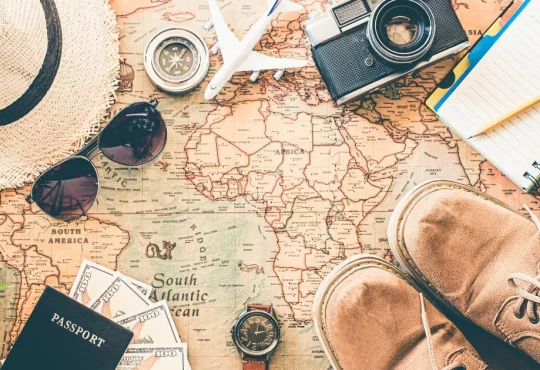Regarding long-haul travel, one of the most daunting challenges is getting quality sleep on the plane. At Humankind, our team has meticulously curated seven effective strategies to help you achieve better rest in flight. These tips are essential to ease into relaxation amidst the clouds, ensuring you arrive at your destination feeling rejuvenated and ready to embark on your travel adventure with renewed energy and vitality.
Improve Flight Comfort: Tips for Better Plane Sleep 2024!
Timing and Seat Selection
Consider flight timing and seat selection to optimize comfort and rest on long-haul flights. Choosing a daytime flight that lands in the evening can reduce the pressure to sleep during travel, especially if sleeping on flights is challenging. For back-to-back long-haul journeys, booking a brief stay at a transit hotel for rest can be preferable to enduring the entire trip on minimal sleep. Always prioritize booking seats in advance to secure the most comfortable option possible, utilizing resources like SeatGuru.com to identify seats with extra legroom and minimal disturbances, such as those in quieter sections like the front of economy class, often reserved for families with young children.
Book nonstop flights
Booking nonstop flights, especially those lasting 10 hours or more, is ideal for maximizing rest during travel. Unlike shorter flights or those with layovers, nonstop flights offer uninterrupted periods conducive to catching up on sleep without the disruptions of plane changes or airport waits. This reduces overall travel time and minimizes stress, ensuring passengers arrive at their destination refreshed and prepared for their journey.
Secure a seat with an empty spot next to you.
Try to secure a seat with an empty spot next to you, although this can be challenging due to airlines maximizing every available space. It’s worth checking the seat map online the night before your flight to see if any seats are available next to empty spots. Remember that window seats tend to be taken first, so getting both a window seat and an adjoining empty spot may be challenging. Consider selecting a seat in a less crowded plane section or a seating arrangement that allows for more privacy and space, enhancing your comfort and chances of getting some rest during the flight.
Visibility of Seat belt buckle
Ensure your seat belt buckle is visible during your flight to avoid unnecessary interruptions from flight attendants, especially during turbulent conditions. Ensuring your seat belt is fastened and visible complies with safety regulations and signals the crew that you are prepared and aware of safety protocols. This proactive approach can contribute to a smoother and more comfortable flight experience, allowing you to focus on relaxing or sleeping without concerns about being disturbed. By keeping your seat belt readily accessible and visibly fastened, you can minimize potential disruptions and enjoy a more uninterrupted journey.
Utilize Your Carry-On
Using your carry-on as a footrest during long flights can provide much-needed relief for aching knees from extended sitting and subtly mimic the comforting fetal position associated with relaxation and sleep. To optimize this trick, pack durable items on top of your carry-on to safely support your legs without risking damage to your belongings, ensuring a more comfortable and restful journey. Alternatively, consider placing your carry-on bag in your lap during the flight as a stable surface to lean on and rest your arms, offering better support than leaning forward on a tray table and enhancing overall comfort during travel.
Medication, Food and Beverages Intake:
If you have a preferred sleep aid, whether pharmaceutical or herbal, take it in advance, possibly with dinner, and avoid consuming caffeine and alcohol. However, a glass of wine with your meal may aid relaxation.
Take a Melatonin Pill
Consider using melatonin as part of your flight sleep strategy. This hormone regulates sleep cycles naturally, aiding relaxation and promoting restfulness. Taking melatonin a few hours before your flight can help adjust your body’s internal clock to the new time zone or improve your sleep environment onboard. While melatonin can assist with relaxation, its effectiveness varies based on individual factors. Purchasing melatonin before your trip is wise, as availability differs between countries and may not be easily found elsewhere. This ensures you have this natural sleep aid on hand for your travels.
Sip a Hot Herbal Tea
Sipping on a hot beverage, such as herbal tea like chamomile or lavender, can be a delightful ritual to aid relaxation during your flight. Bringing your tea bags ensures you have your preferred calming blend on hand, although you’ll need to request hot water from a flight attendant. Herbal teas are known for their soothing properties, helping to create a tranquil atmosphere conducive to rest. It’s advisable to steer clear of caffeine, including in green tea, as it can interfere with your ability to unwind and sleep peacefully during the flight. Embracing this simple practice enhances your comfort and promotes a more serene travel experience overall.
Take a Drink of Alcohol
Alcohol can be a mixed blessing during flights—it’s not suitable for everyone and can dehydrate you, but for some, a drink or two can help induce relaxation. While some doctors caution that alcohol can disrupt sleep quality, I’ve never managed deep sleep on a plane anyway, so I use every available method to unwind. My advice: Skip beer to avoid frequent bathroom trips, and limit yourself to one or two drinks as alcohol affects you more strongly in the air. Overindulging can lead to feeling the effects the next day, so aim to drink just enough to relax without becoming intoxicated.
Decline the Meal Service
To maximize your rest on a flight, it’s best to decline the meal service, as being interrupted by dinner for two hours can significantly reduce your sleep time. Instead, focus solely on resting and save eating for the end of the flight when you arrive at your destination. Bring a light snack with you if you need something in your stomach to help you sleep. This approach will help you make the most of your rest time, ensuring you arrive more refreshed.
Prioritize Comfort over Style:
Wear a Sophisticated Yet Cozy Clothing
Regardless of your seating class, prioritize comfort over style when flying long-haul. Opt for lightweight knits, comfortable sweatpants or stretchy trousers, long cardigans, and soft sleep socks for a sophisticated yet cozy ensemble. Avoid clothing that wrinkles easily. If you prefer not to wear your “flying clothes” in the airport, change into them after boarding to keep your other clothes fresh when you arrive. Bringing along a soft wrap made of natural fibers like cashmere, wool, or knitted cotton will add warmth and comfort, allowing you to relax and drift off more easily. Plus, draping it over your head creates a private space, signaling to others that you prefer not to be disturbed during your flight.
Bring Your Supportive Memory Foam Pillow /Pillowcase
Comfort and support are crucial at 10,000 meters, and while airlines typically provide a blanket and pillow, these items offer minimal support. Using them strategically is more effective, such as adding extra padding against the window or filling gaps for added comfort. We recommend bringing your supportive memory foam pillow for a truly restful sleep on long-haul flights. Additionally, getting a comforting item from home, even something as small as a pillowcase, can greatly enhance your flight experience. The familiar scent associated with bedtime can help relax your mind and facilitate better sleep, which is especially beneficial for children, providing them a sense of security and comfort in an unfamiliar airplane environment.
Use a Noise-Canceling Headphones
Invest in earplugs for their effectiveness in reducing ambient noise during flights, addressing all the usual reasons for their use. Additionally, layer noise-canceling headphones over the earplugs, especially crucial when traveling near infants whose cries can easily surpass earplugs’ abilities (apologies to the little ones). For further sound insulation, play soft music through the headphones; I find the plane’s classical music options ideal as they lack lyrics and predictable beats, offering triple protection against sudden noises.
Avoid Exposure to Light:
Adjust the Brightness of Your Mobile Phone
To enhance your chances of achieving restful sleep during a flight, minimizing exposure to light, especially blue light, is important before bedtime. Start by adjusting the brightness settings on your mobile devices and seatback entertainment screen to create a soothing environment for yourself and ensure a more comfortable experience for fellow passengers. Avoiding the glare from a neighbor’s screen, particularly when using it while wearing a sleep mask, can significantly improve the overall flight atmosphere and contribute to a more restful journey for everyone onboard.
Turn Off Your Seatback Screen
Additionally, consider turning off your seatback screen or switching it to display the flight map rather than dynamic content. The continuous flickering and changing screen patterns can disturb sleep and hinder relaxation. Opting for a static image like the flight map helps create a quieter setting conducive to rest. These adjustments benefit your ability to rest and promote a more peaceful atmosphere for all passengers, enhancing the overall quality of the flight experience.
Use a Sleeping Mask & Neck Pillow
Consider incorporating a sleeping mask and neck pillow into your flight comfort routine to improve your rest. While I haven’t personally found them effective in the past, many travelers swear by their ability to enhance comfort and promote sleep during flights. A sleeping mask can help block light and create a darker environment, signaling your body that it’s time to rest. Similarly, a supportive neck pillow can alleviate strain and discomfort, especially during long journeys. Experimenting with these accessories may yield different results for each individual, so they are worth trying to see if they can contribute to a more relaxing and rejuvenating travel experience.
Cover Your Head with a Blanket
Covering your head with a blanket on a flight can be a game-changer for getting quality rest, and I don’t mind if others think I look strange or even share my picture on Passenger Shaming. While they arrive looking like shambling zombies, I’ll be bushy-tailed and refreshed. Something about retreating into my cloth bubble helps me drift away, whether it’s the psychological comfort, decreased light, or even the increased carbon dioxide levels. Whatever the reason, this simple trick often works wonders for achieving restful sleep during a flight.
Do Your Bedtime Rituals
Research indicates that bedtime rituals are beneficial for promoting sleep. Engaging in familiar pre-sleep activities, such as changing into comfortable clothing, brushing your teeth, washing your face, and even applying a hydrating face mask, can help prepare your mind and body for rest. Before settling in, ensure you’ve visited the restroom and inform your neighbor that you’ll be resting. Once settled, wrap yourself in a blanket, use an eye mask and earplugs for added comfort, and adjust your seat belt loosely over the blanket to avoid disturbance by flight attendants during turbulence.
Apply Scented Lotions
Applying scented lotions with relaxing fragrances like lavender, chamomile, rose, bergamot, or sandalwood can be a soothing ritual for some travelers. However, it’s important to consider your neighbors, as not everyone may tolerate strong perfumes or scents well and may find it unpleasant or rude.
Conclusion:
Regardless of your chosen method, the key objective is to adjust to your destination’s time zone as quickly as possible upon arrival. Aim to schedule your arrival so that you can stay awake until a reasonable bedtime—ideally, about 2 to 3 hours before your usual sleep time at home. Achieving this can significantly ease the transition, making the second day at your destination feel much closer to normal.





